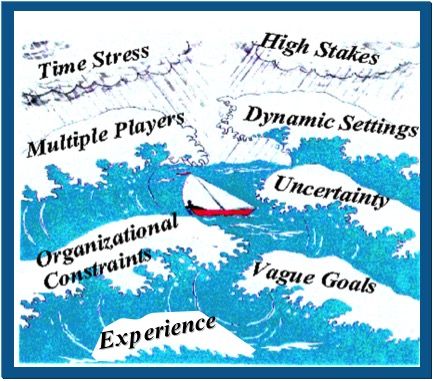Decision-Making
The Naturalistic Decision Making Approach
What we have learned by studying cognition in the wild
Posted February 1, 2016
What is Naturalistic Decision Making (NDM)?
NDM is the research tradition begun in the 1980s to study how people actually make decisions — people such as firefighters, military commanders, nurses, design engineers, pilots, and petrochemical unit managers. NDM examines the kinds of decisions they make in the course of their work, and how they use their experience to cope with challenging conditions such as time pressure, uncertainty, vague goals, high stakes, organizational constraints, and team coordination requirements. The NDM approach is thus a contrast to judgment and decision paradigms that use pre-defined tasks given to naïve subjects under controlled laboratory conditions.

How NDM got started
In the late 1980s, Judith Orasanu, working in the Basic Research group at the Army Research Institute, assembled a cadre of researchers who were investigating decision making in natural settings, using cognitive ethnographic methods. Orasanu and Gary Klein, one of these researchers, convened a small workshop in 1989 to bring this community together to share ideas. One outcome of this workshop was an edited book, Decision Making in Action (1993). Since that time, a dozen NDM conferences have been held, at roughly two-year intervals, alternating between the U.S. and Europe. Many of the conferences have generated edited volumes. In addition, the Cognitive Engineering and Decision Making Technical Group was established in 1995 to provide an annual opportunity for NDM researchers to exchange ideas; it quickly grew to become the largest Technical Group within the Human Factors and Ergonomics Society.
What has the NDM movement achieved?
Many people are excited by the NDM approach and the possibilities it opens up. But other people are skeptical about whether we can learn anything without carefully controlled experiments. The way to assess NDM research is to see what it has discovered. Here is a summary, taken from some recently published articles.
We used to believe that the only way to make good decisions was to generate several options and pick the best one. NDM studies found that experienced decision makers recognize patterns and don’t compare options. They evaluate an option by imagining how it would play out.
We used to believe that expertise depends on learning rules and procedures. NDM research demonstrated that expertise primarily depends on tacit knowledge.
We used to believe that projects had to start with a clear description of the goal. NDM researchers saw that challenging projects involve wicked problems and ill-defined goals that cannot be specified in advance. The goals become clarified while they are being pursued.
We used to believe that people make sense of events by building up from the data to information to knowledge and finally to understanding. NDM studies showed that experienced decision makers use their mental models to define what counts as data in the first place. And as discoveries are made about the nature of a situation, different aspects of the data are revealed.
We used to believe that insights arise by overcoming mental sets. NDM research discovered that insights also arise by detecting contradictions and anomalies and by noticing connections.
We used to believe that we could reduce uncertainty by gathering more information. NDM researchers found that performance seems to suffer when too much information is gathered, and that uncertainty can result from inadequate framing of data, not just the absence of data.
We used to believe that we could improve performance by fostering critical thinking practices such as listing assumptions. NDM researchers noted that the flawed assumptions are often unconscious, and thus could never get listed.
Where is NDM heading?
As you can see from the preceding section, NDM researchers have broadened their investigations. They are not just interested in decision making. They study other cognitive processes such as situation awareness, sensemaking, problem detection, and anticipatory thinking. They use naturalistic inquiry methods to explore a range of macrocognitive phenomena (as opposed to microcognitive phenomena studied under controlled laboratory conditions).
In addition to trying to understand more aspects of thinking in complex settings, NDM researchers are also seeking ways to improve performance: better decision making, better sensemaking, quicker and more accurate problem detection. In contrast to the behavioral decision making community which focuses on human limitations and tries to reduce biases, NDM researchers try to understand human capabilities. While it is important to cut down on mistakes, good performance is not just the absence of mistakes — it consists of discoveries and achievements. It depends on the strengths of decision makers. Unlike research approaches that seek to debunk experts, NDM practitioners are impressed by experts, whether they are expert firefighters or physicians or pilots or military commanders. And so NDM practitioners are seeking ways to bring people up to speed more quickly.


